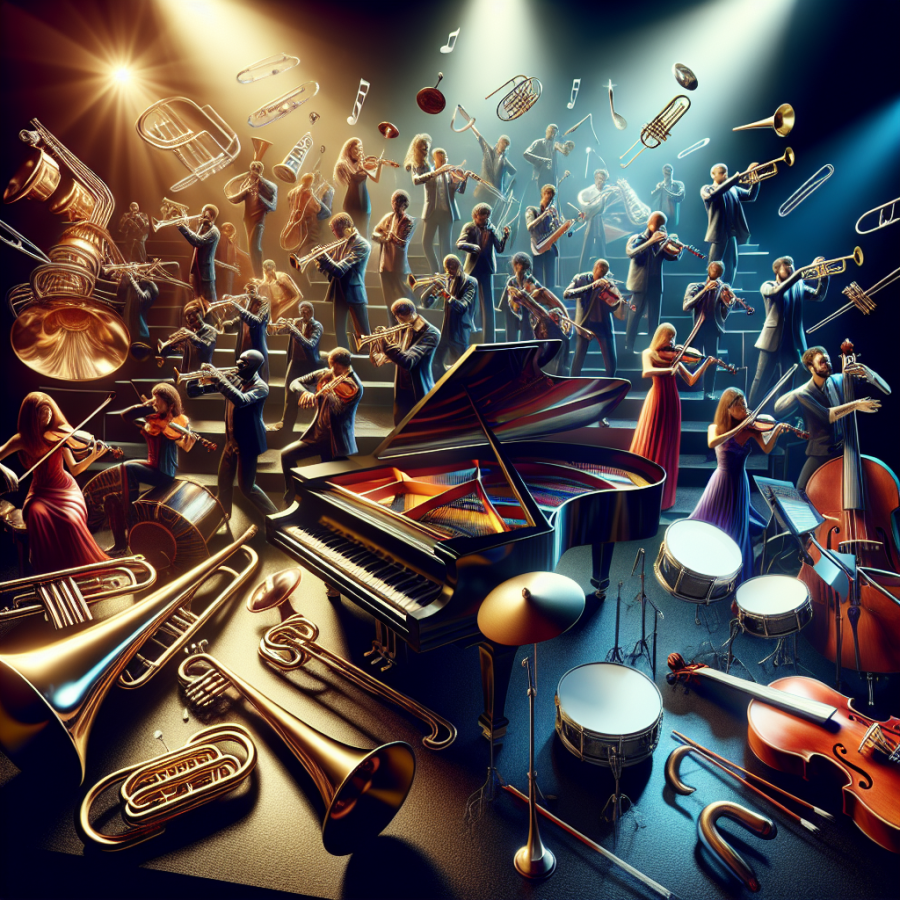Synchronizing Skill Sets: A Glimpse into the Harmonious Battle of Bands at the Music Clash Event
As we delve deeper into the melodic spectacle at the Annual Music Clash, it is essential to address a critical component that often goes unnoticed, yet is the backbone of every successful performance: synchronizing skill sets. This year's event has convincingly highlighted the reality that the harmony of a band is not merely a synergy of instruments, but a complex dance between distinct musical talents, learning experiences, and technical expertise.
At the heart of this harmonic convergence is the seamless blend of individual competencies. Each band member brings forth a unique set of skills that, when combined, create a comprehensive musical experience. The lead guitarist's swift fingers dance over the fretboard with a mastery obtained through years of disciplined practice, while the bassist provides the rhythmic foundation, grounding the music with rich, resonant tones that bridge the gap between rhythm and melody.
The synchronicity extends to the dynamic interplay between the drummer and the rest of the ensemble. The drummer's role transcends mere timekeeping; they anticipate crescendos and decrescendos, responding with a keen sense of timing that accentuates the emotional expression of the piece. This interdependence is the cornerstone upon which the bands build their signature sound, which captivates the audience at the Music Clash.
Vocalists, too, play a pivotal role in weaving the sonic tapestry. Their ability to modulate tone, volume, and emotion in sync with their bandmates elevates the performance from a mere rendition of notes to a profound musical narrative. The challenge of blending the raw emotion of the vocals with the instrumental arrangement underscores the significance of skill synchronization.
Each band we witnessed showcased a tremendous capacity for intra-band communication, a non-verbal dialogue that is essential for live performance. The subtle cues—a nod, a glance, a shift in body language—are the secret language of the band, ensuring they remain in harmony despite the chaos of a live environment. This is especially crucial during improvisational moments when bands venture off the scripted path to explore the spontaneity of their craft, relying wholly on their collective tight-knit chemistry to maintain cohesion.
Even the technical crew plays a vital role in this symphonic alliance. Sound engineers, lighting technicians, and stage managers work behind the scenes to ensure the band's skillful performance is experienced as intended. Their expertise in fine-tuning acoustics and visuals to match the band's dynamics is another layer of skill synchronization that shouldn't be overlooked.
Unleashing Melodic Mastery: The Fierce Competition at This Year's Annual Music Clash
Unleashing Melodic Mastery: The Fierce Competition at This Year’s Annual Music Clash
As the curtains rose at this year's Annual Music Clash, the air was thick with anticipation. Talented musicians from across the globe had gathered, instruments in hand and melodies at the ready, determined to impress both the audience and the discerning panel of judges. This year, the stakes seemed higher than ever, with a record number of participants vying for the coveted title of Music Clash Champion.
One of the most captivating aspects of the competition was the diversity of genres on display. From the soul-stirring strings of classical violinists to the rhythmic beats of contemporary drummers, each performer brought a unique flavor to the stage. Folk ensembles intertwined with electric guitar solos, while jazz pianists dueled against the powerhouse vocals of opera singers, creating a spectacle of harmonic convergence that left spectators in awe.
In the instrumental category, a young prodigy from a small town stunned the audience with a virtuosic piano piece, her fingers dancing across the keys with a precision that belied her years. Not to be outdone, a group of classical guitarists engaged in a flamenco-inspired performance so passionate it set the stage alight with its intensity. Each pluck of the strings seemed to tell a story, leaving the crowd hanging on every note.
Vocalists, too, were a cornerstone of the competition. A barbershop quartet charmed the audience with their impeccable harmonies and nostalgic repertoire, transporting listeners back to a simpler time. In contrast, an up-and-coming pop singer delivered a high-energy performance, masterfully layering electronic sounds with her powerful voice, signalling a new era in musical fusion.
The original composition category was as fiercely competitive as ever. Seasoned composers and new talents alike presented their works, some pieces quietly haunting and others bold and avant-garde. A jazz-infused orchestral number threw a curveball into the competition, blending swinging rhythms with lush orchestral harmonies in a way that was both innovative and delightful to the ear.
Ensembles were not left behind in showcasing their prowess. A symphony orchestra, comprised of musicians from various countries, performed a piece that was a testament to the unifying power of music. As the strings, woodwinds, brass, and percussion sections came together in a crescendo of sound, it was clear that this collective effort was one of the highlights of the event.
Finding the Right Balance: Harmonizing Talent at Music Festivals
Music festivals showcase a medley of talents where artists, bands, and performers with different styles, sounds, and cultures come together under one harmonious event, but it's the Annual Music Clash where the concept of harmony is put to the ultimate test. Harmonizing talent in such dynamic settings is both an art and a science. Event organizers must meticulously curate lineups that not only complement one another but also offer audiences a sonic journey through various genres and performances.
Sound Strategies for Talent Curation
The art of harmonizing talent begins with understanding the audience. Curators must dive deep into demographics, preferences, and trends to strike the right chord with festival-goers. Effective strategies involve crafting a lineup that reflects diversity in music while ensuring that performers resonate with the audience's expectations.
To achieve this, festival organizers often utilize data analytics from previous events, social media monitoring, and streaming platform trends. This information guides them in selecting acts that will not only attract attendees but also encourage them to stay engaged throughout the event. By blending emerging local acts with established headliners, festivals provide both novelty and a sense of familiarity, which is key to harmonization.
Balancing Genres and Schedules
Equal attention must be given to scheduling to avoid overlapping of similar genres or artists that might appeal to the same subset of the crowd. Effective scheduling ensures that attendees can fluidly move from one performance to another, experiencing a natural progression of music throughout the day. This can mean placing a soothing folk ensemble after an electrifying rock performance, giving the audience a change of pace and maintaining their energy levels.
Additionally, stages must be set up in a manner that minimizes sound interference between them, allowing each act to be heard clearly. Sound zones are carefully engineered to ensure the perfect mix of acoustics and volume, delivering the best auditory experience possible.
Engagement Beyond the Performance
Talent harmonization doesn't end with the music. Interactive experiences, such as meet-and-greets, workshops, and Q&A sessions with artists, add a layer of engagement that enriches the festival atmosphere. These activities can be scheduled in-between performances to keep the interest piqued and offer a behind-the-scenes look into the world of music.
Furthermore, integrating other forms of entertainment, such as visual arts, dance performances, and cultural displays, weaves a tapestry of immersive experiences.




